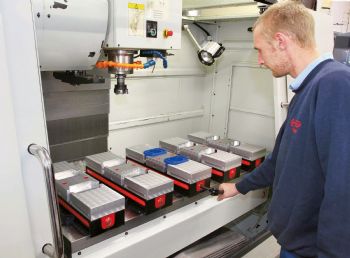
No matter how fast a machining centre is, the speed and efficiency with which parts can be clamped, presented to the spindle and unclamped afterwards defines the productivity of a process; this is demonstrated by the Gosport-based sub-contractor and precision engineering firm QCD Ltd, which is gaining huge benefits by using Chick twin-station work-holding devices supplied by the US manufacturer’s UK agent, Salisbury-based 1st Machine Tool Accessories Ltd (
www.1mta.com).
Established in 2000, QCD mainly serves the cosmetics, pharmaceutical, defence, nuclear, motor-sport and aerospace industries.
Owner and managing director Steve Lindsell has evaluated the cost savings and productivity increases resulting from the new clamping arrangement.
Overall, £50,000 per year is being saved using five Chick Qwik-Lok work-holding units compared with when components were secured in the same number of traditional wind-up vices.
As the new clamps cost just £6,000, the investment was amortised in 46 days from delivery.
QCD specialises in using a Faro arm to reverse-engineer and subsequently machine parts for production machinery, which it does faster and at a lower cost than OEMs in Germany and Italy.
The required finish on some plastic components is high at 8CLA, and dimensional tolerances are typically ±0.05mm. Batch sizes are between 100 and 500, and the turn-round time is normally two or three days — sometimes just one day if a broken component has stopped a production line.
Hurco VMCs undertake all the prismatic machining at Gosport, and it is on the table of a three-axis VM3 model that the five twin-station Qwik-Loks provide 10 clamping positions.
Mr Lindsell has calculated that by fixturing 10 parts at a time rather than one, the cycle time per part is halved — typically from 4min to 2min.
The aforementioned plastic components undergo a roughing operation (Op 1) held in hard jaws on five conventional twin-station vices on another VMC.
The jaws are not changed to suit different sizes and shapes of component, so this first operation is cost-effective.
The parts are then transferred to the five Qwik-Loks on the VM3 for finish milling and drilling (Op 2) while held in soft aluminium jaws machined to match the shape of the component.
The jaws snap on and off quickly, using Chick’s System 5 Qwik-Change technology.
They can be turned around to allow another shape of part to be held by a different machined face on the other side of the jaw — or replaced by an entirely different set of jaws.
Mr Lindsell said: “Repeatability of positioning on the Qwik-Loks is excellent, which means that components are machined more accurately.
"Five complete change-overs are achieved in just 15min; this is our biggest cost saving. With the type of twin vice we use for Op 1, it used to take a whole day to change over a set of soft jaws and clock them into position for Op 2.
"Then we might only produce 100 parts before having to change the jaws back again. It was a recipe for losing money.”
Another benefit is a reduction in swarf-related problems; comprehensive swarf removal was needed due to the large number of traps in conventional vices for harbouring chips which, if not removed, would compromise machining accuracy.
Manual swarf removal is no longer necessary with the Chick clamps (a spindle-mounted chip fan is incorporated into the machining cycle), as their working parts are fully enclosed and protected from swarf and coolant ingress.
This sealed construction provides another significant saving, as conventional vices need to be dismantled three or four times a year to clean out the swarf and de-rust the leadscrews; this took four operator-days each time when cleaning a set of five conventional vices.